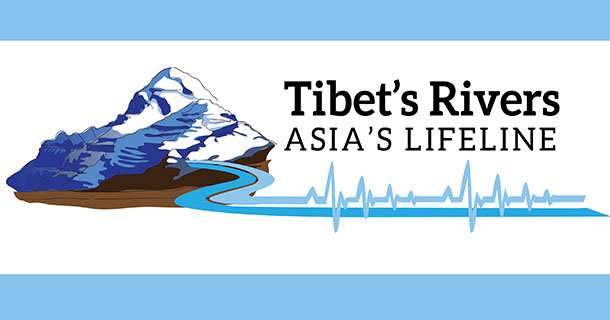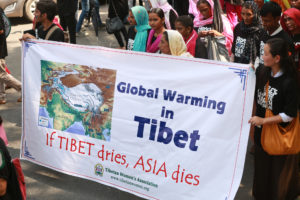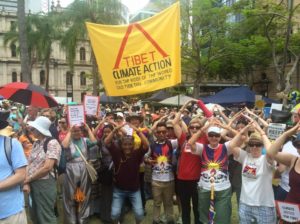TIBET: Time to Declare a Climate Emergency
By Michael Buckley
 On Friday, September 20 and 27, students around the world will strike for climate crisis action — joined by adults — with protests planned for hundreds of cities around the world. Tibet 3rd Pole* is calling on Tibetans to join the action to add their voice and to draw attention to the Tibetan perspective. Tibet should be at the forefront of any discussion about the climate crisis.
On Friday, September 20 and 27, students around the world will strike for climate crisis action — joined by adults — with protests planned for hundreds of cities around the world. Tibet 3rd Pole* is calling on Tibetans to join the action to add their voice and to draw attention to the Tibetan perspective. Tibet should be at the forefront of any discussion about the climate crisis.
By some calculations, the planet has 12 years left. By other calculations, just 7 years left. And according to Prince Charles, we have just 18 months left. What is under debate here is how long is left before the planet reaches the point of no return. Translation: drastic changes caused by the climate crisis at some point will become irreversible.
England declared a Climate Emergency in May 2019. Followed by Ireland. The Pope declared a Climate Emergency. Some 7,000 universities and colleges around the world have united to declare a Climate Emergency. China and India have not indicated any leanings to join in, as both nations are sitting on economies that depend on copious numbers of coal-fired power plants, and neither nation has any intention of weaning off coal. Both nations mention vague figures like reducing coal consumption by 2030, which is far too late.
Lying between the world’s most populous nations, China and India sit Tibet—an occupied region, under China’s iron-fisted rule since 1950. Tibet is the forgotten part of the Climate Crisis conversation. There’s a lot of press about the Arctic melting and Antarctic melting, but precious little about the meltdown at ‘the Third Pole’, meaning the Tibetan Plateau. This vast region does what the other two poles cannot—it supplies a dozen nations downstream with freshwater. In fact, the rivers sourced in Tibet supply freshwater to over 1.5 billion people downstream–which represents a fifth of the entire global population. And that supply of water starts with dripping glaciers in Tibet. Which is melting twice as fast as originally thought, according to recent research that compares spy satellite mapping from the 1970s with satellite mapping from today?
 Tibet sits on the largest area of permafrost outside of the Arctic and Antarctic–and that is rapidly thawing too, which could release large amounts of methane–a greenhouse gas 30 times more potent than CO2. Tibet’s vast swathes of grassland are highly effective carbon sinks–and these grasslands are under attack from rampant Chinese mining ventures, which have accelerated since the arrival of the train in Lhasa in 2006. This has led to encroaching desert taking over grasslands.
Tibet sits on the largest area of permafrost outside of the Arctic and Antarctic–and that is rapidly thawing too, which could release large amounts of methane–a greenhouse gas 30 times more potent than CO2. Tibet’s vast swathes of grassland are highly effective carbon sinks–and these grasslands are under attack from rampant Chinese mining ventures, which have accelerated since the arrival of the train in Lhasa in 2006. This has led to encroaching desert taking over grasslands.
Why does this matter? In the short run, rapidly melting glaciers pose a threat from major flooding. This particularly is evident with the creation of glacial lakes that build up, and when they burst, will bury villages in mudslides. In the long run, melting glaciers pose a threat not seen in thousands of years. If the glaciers vanish, the rivers of Tibet will run dry, only fed by monsoon rainwater. And dozens of Chinese megadams on the rivers of Tibet will cease to operate. And billions will be without river water. China and India have groundwater supplies, but these have been tapped to the point where precious little remains.
Some scientific surveys say that around 50 percent of the meltdown of Himalayan glaciers is caused by CO2 emissions, with China responsible for around 30 percent of the global total for emissions of this deadly greenhouse gas, and India responsible for around 7 percent. And the other 50 percent of meltdown could be due to the rain of black soot on the Himalayas, from both Chinese and Indian sides.
Black soot, aka Black Carbon, is not a greenhouse gas. It is a rain of minute particles from the burning of fossil fuels like coal, wood, and from sources like diesel engines. Tiny PM2.5 particles are highly hazardous to human health because they can get into the lungs—and stay there. Deadly for humans–and deadly for glaciers. Glaciers are adversely affected by the same particles, whether PM2.5 or PM10 versions. Black soot lands on the glaciers and stays there—which then attracts the sun. The ice and snow of glaciers reflect the sun, but the black particles absorb the sun, leading to a more rapid meltdown .
.
Black soot is a totally solvable issue. If the burning of fossil fuels in both China and India were to stop, black soot would disappear within a month. Improved cookstoves, for instance, can greatly reduce the impact of billions of people in China and India using wood, charcoal, and coal for cooking. But neither China nor India has taken any substantial steps to even reduce the output of black carbon from coal-fired power plants—despite both nations making pledges at the 2015 Paris Climate Agreement.
On this basis alone, it is time to declare a Climate Emergency in Tibet. China has never participated in any mass demonstrations targeting the Climate Crisis, such as those sweeping Europe via school strikes for global action and Extinction Rebellion. India has participated in such protest, with a number of NGOs involved. But a lot more needs to be done to galvanize politicians and leaders into action to solve the issue of the meltdown in Tibet. Otherwise, the planet faces a stark choice: our very survival is at stake. Across Asia, disasters like flooding and cyclones are becoming more frequent, resulting in hundreds of thousands of climate refugees on the move. What happens in Tibet is much more than an Asian problem: it will have major impact for the entire planet. We no longer have the luxury of procrastination: the time to act is now.
Michael Buckley is the author of “Meltdown in Tibet” and the digital photo book “Tibet, Disrupted”–both available on Amazon India.
- Tibet Third Pole is coordinated by the International Tibet Network, with Free Tibet, Students for a Free Tibet, Australia Tibet Council, Swedish Tibet Committee, Danish Tibet Committee, Tibet Initiative Deutschland and the Tibetan Women’s Association. Tibet Third Pole is advocating for action to alleviate the global climate crisis with particular concentration on the protection of the Tibetan Plateau, their message is: Tibetans and their supporters stand in solidarity with people around the world affected by the climate crisis, and call for an ambitious, binding government agreements that uphold human rights, and will enable Tibetans to be part of the solution.


comment 0